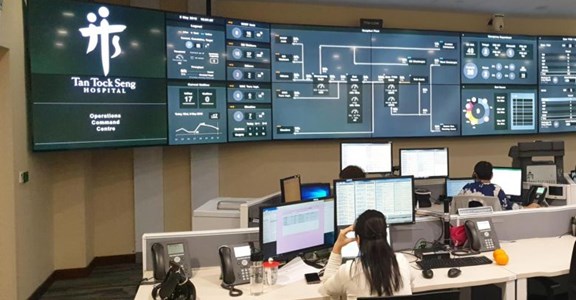
Transforming Healthcare With Technology
Digitalisation of Tan Tock Seng Hospital
Known as the “People’s Hospital,” Tan Tock Seng Hospital (TTSH) is one of the largest multidisciplinary hospitals in Singapore. Renowned for its world-class patient care and comprehensive range of high-quality holistic healthcare services, TTSH has 27 clinical departments and a full range of sub-specialities to meet the diverse healthcare needs of patients. TTSH also houses major centres of excellence, including the Ng Teng Fong Centre for Healthcare Innovation (CHI) and the National Centre for Infectious Diseases (NCID).
ST Engineering’s experience and expertise in flexible system integration services support TTSH’s digitalisation journey, transforming its health information systems.*
Transformation
Improved Manpower Efficiency by 15% requiring only 2-3 resources per shift to manage 2,000 beds
20% improvement in Bed Turnover Time from 30 to 24 minutes
Increased capacity by eliminating Patient Flow choke points and optimise hospital resources to meet sudden demands spike
“For me, innovation starts with understanding what our patients and the wider population value. We redesign our care to drive that value, add the relevant technologies to empower that care, and transform the workforce with better digitally enabled jobs.“ Professor Eugene Fidelis Soh, former CEO of Tan Tock Seng Hospital, now Deputy GCEO (Population Health), National Healthcare Group |
The Challenge
Overcoming complexities to accelerate a digital health strategy
To ensure high-quality patient care delivery, healthcare providers like TTSH must navigate the challenges posed by Singapore's rapidly ageing population and insufficient local workforce. The growing weight of chronic disease and the increasing complexity of such conditions add to the demands faced by hospitals, placing pressure on healthcare professionals and existing infrastructure.
Building on the lessons learned from the SARS outbreak in 2003 and the more recent COVID-19 pandemic, it is also crucial for TTSH to enhance its pandemic preparedness and response strategies. These strategies should be dynamic and flexible, capable of addressing both known and emerging disease threats.
Combining remote and in-person care using digital solutions is essential for more holistic and integrated healthcare delivery. For example, telehealth—leveraging digital information and communication technologies—can help reduce hospital waiting times.
Moreover, the surge in healthcare data requires adopting interoperability solutions to unlock its full benefits from disparate systems. Mitigating cybersecurity threats is paramount, given that healthcare data is a prime target for cybercriminals. Ensuring data privacy and compliance with national data protection regulations are crucial components of this effort.
The Solution
A state-of-the-art Command Centre
ST Engineering collaborated with TTSH and Singapore's health tech agency IHiS (now known as Synapxe) to develop a cutting-edge Hospital Operations Command Centre featuring a state-of-the-art Command, Control and Communications (C3) system. This platform leverages our expertise on data management in a command centre to integrate data from various hospital sources, enabling real-time aggregation and contextualisation of information from disparate systems.
Leveraging GenAI, the system optimizes capacity through predictive analytics, data modeling and machine learning on beds, patients and equipment to enhance operational efficiency. It also provides situational awareness for timely, informed and collaborative decisions, facilitating improved patient flow and effective responses to fast-changing on-the-ground situations.
The Command Centre shifted focus from mere resource management to enabling seamless patient flow throughout the system by identifying choke points and reducing waiting times.
Incorporating engineering expertise into tracking of IoT devices in a hospital allows the Operations Command Centre to also manage hardware resources. One example is tracking robots within the hospital or health condition of a wearables on a patient.
The Result
Improved operational efficiency and patient care
Our platform solutions significantly enhance operational efficiency and alleviate stress on hospital capacity, ensuring a seamless patient journey from registration to billing. The C3 system's automation of workflows improves the patient care experience, enabling hospital staff to prioritise patients’ recovery. For instance, across TTSH-NCID, only two to three individuals now manage the allocation of 2,000 beds, and nurses can devote more attention to patient care owing to reduced administrative burdens.
When faced with unprecedented challenges like the COVID-19 pandemic, TTSH management now has better tools to cope with fast-evolving crises. Implementing digital technology aids hospital operations in making swift, informed decisions under time pressure. Thanks to the Hospital Operations Command Centre and C3 system, TTSH-NCID could attend to 70% of all confirmed and suspected COVID-19 cases in Singapore.
The key to its success in outbreak responses lies in effective communication and coordination of hospital-wide operations, driven by timely data from multiple systems and the frontline. For instance, at NCID’s Covid screening centre, every movement was recorded for contact tracing, facilitated by real-time location sensors on staff, patients and equipment. This allowed for constant monitoring, load balancing and adherence to safety protocols. Predictive analytics and AI helped forecast bottlenecks and patient discharges, enabling adjustments in workforce distribution and timely procurement of supplies like personal protective equipment and COVID-19 medication. Additionally, analytics monitored test volumes to track waiting times for results at the screening centre.
The system also bolsters security and addresses cyber threats and data privacy concerns.

“Digitalisation empowers care to be delivered anytime, anywhere, and AI can address its complexities to make care simple at the front end.”
Professor Eugene Fidelis Soh, Deputy GCEO (Population Health), National Healthcare Group
Future Plans
Ongoing innovation for continuous improvement
Continual innovation is essential for sustaining efficient hospital operations, and staying abreast of technological advancements is crucial for strengthening patient care. TTSH’s plans involve installing additional sensors in various hospital areas to collect and integrate data with the command centre. This initiative will offer fresh insights and prompt necessary alerts for immediate attention, further enhancing its ability to deliver quality care.
Over time, C3 will also incorporate machine learning and predictive analytics to ensure better proactive actions and forward planning, rather than relying solely on reactive measures.
The next step for C3 is to go upstream to include pre-hospital care and downstream to transit care back into the community. Going upstream can help prevent unnecessary admissions, provide for fewer years spent in disability and empower patients towards better health.
“Backed by a robust C3 system, we will be prepared for any crisis and execute decisive protocols in a heartbeat.“ Dr Jamie Mervyn Lim, former COO of Tan Tock Seng Hospital, now CEO of Ren Ci Community Hospital |
Key Outcomes and Benefits
- Better management of resources
- Improved patient care delivery, including shorter wait times
- Better communication and coordination of responses
- A more holistic view of hospital operations
- Optimised patient flow
- Strengthened security to address cyber threats and protect data privacy
“Because of the use of technology, manual administrative work is reduced for nurses, and allows them to focus on caring for the patients.“ Dr Jamie Mervyn Lim, CEO of Ren Ci Community Hospital |
*Sources: Tan Tock Seng Hospital, National Healthcare Group
Get in touch
Subscribe to our newsletter
Copyright © 2024 ST Engineering
By subscribing to the mailing list, you confirm that you have read and agree with the Terms of Use and Personal Data Policy.

